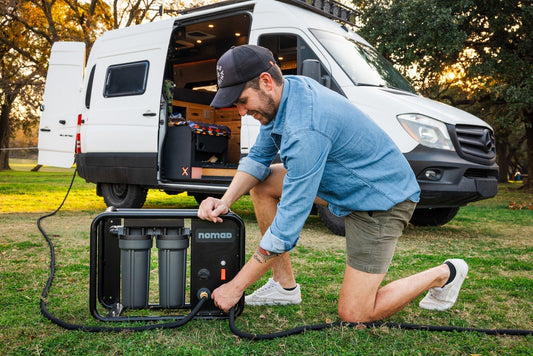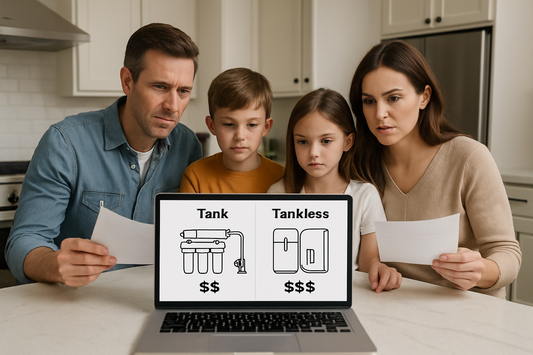Compare Modern RO Options for the Healthiest Water in Small Spaces
If you’re like many Americans seeking safe, clean water at home, reverse osmosis (RO) filtration is likely on your radar. And for good reason—it’s one of the most reliable water purification methods on the market. But the question remains: should you install an under sink reverse osmosis system, or is a countertop RO unit more suited for your space and lifestyle?
This guide will not only walk you through installing a modern under-sink RO system—it will also compare it side-by-side with countertop alternatives, so you can choose what’s best for your kitchen and family.

Photo by macrovector
💡 Why Choose Reverse Osmosis Water Filtration?
Reverse osmosis works by using pressure to push tap water through a semi-permeable membrane, filtering out impurities. These include:
-
Chlorine and chloramine
-
Lead, arsenic, and heavy metals
-
Fluoride and nitrates
-
VOCs, PFAS, and pharmaceuticals
Modern RO systems, especially tankless under sink units, now offer faster water flow, smarter monitoring, and dramatically reduced wastewater.
⚖️ Countertop vs Under Sink RO Systems: What’s Better?
Both under sink and countertop RO systems clean your drinking water—what differs is how they fit into your life.
Countertop RO Systems
Best for: Renters, apartments, travelers
✅ No plumbing required
✅ Plug-and-play from any faucet
✅ Great for portable or temporary use
✅ Easy to move and clean
🔗 Want a solution with no tools required?
Check out our Countertop Reverse Osmosis Systems
Under Sink RO Systems
Best for: Homeowners, busy families, tech-savvy users
✅ Hidden under cabinet
✅ Fast, on-demand filtered water
✅ Tankless = less wasted water
✅ Long-term investment in water quality
🔗 Want a solution with no tools required?
Checkout our Under sink Reverse Osmosis Systems

Photo by freepik
🛠 How to Install an Under Sink Reverse Osmosis System
Whether it’s your first time or you're upgrading to a tankless RO system, here’s a straightforward guide to install one.
What You’ll Need:
-
Adjustable wrench
-
Drill (for faucet hole, if not pre-drilled)
-
Teflon tape
-
Tubing cutter or sharp scissors
-
A power outlet (for some tankless models)
Step 1: Prep the Sink Area
Clear out space below your sink. Identify the cold water supply valve and nearby electrical outlet.
Step 2: Install the RO Faucet
If your sink doesn’t have an extra hole, drill one. Mount the dedicated RO faucet where it's easy to access.
Step 3: Connect the Cold Water Line
Attach the system’s T-valve to your cold water line. This will feed water into the RO filtration system.
Step 4: Secure the Drain Line
Use a drain saddle to hook the system to your sink’s drainpipe. This lets wastewater exit properly.
Step 5: Mount the System
Install the unit on the cabinet wall or let it stand freely. Connect color-coded tubes to the appropriate in/out ports.
⚡ For tankless systems, plug the unit into your outlet for automatic flushing and water regulation.
Step 6: Flush the System
Run the system for 15–20 minutes to flush out carbon fines and air. Some systems include a TDS meter to track purification.
🔄 RO System Maintenance: Set and Forget?
Routine maintenance helps your under sink system last 5–10 years.
| Filter Type | Replacement Frequency |
|---|---|
| Sediment Filter | 6–12 months |
| Carbon Filter | 6–12 months |
| RO Membrane | 2 years |
| Post-Carbon or Remineralizer | 12 months |
💡 Some tankless RO systems include smart sensors to alert you when filters need replacement—no guesswork needed.
🚀 Advantages of Tankless RO Technology
Tankless under sink reverse osmosis systems are quickly becoming the new standard.
Why?
-
Steady Flow: Water is filtered instantly as you need it
-
Less Wastewater: Ratios as low as 1:1 (vs old tank systems at 3:1)
-
Compact Design: Takes up less space under the sink
-
Modern Features: Leak detection, filter alerts, real-time TDS tracking
These upgrades provide convenience without sacrificing water purity—perfect for tech-forward homes.
🧠 Quick FAQ: What Smart Homeowners Ask
Q: Is under sink RO better than countertop for families?
Yes. Under sink systems deliver more water per day and don’t take up counter space.
Q: What if I rent or travel often?
A countertop reverse osmosis system is more practical—no tools, no plumbing, just clean water.
Q: Does RO water lack minerals?
RO removes both bad and beneficial minerals. Many systems now include a remineralization filter to restore healthy elements.

Photo by freepik
🏁 Final Takeaway
Whether you're looking to save counter space or install a more permanent solution, choosing the right reverse osmosis water filter system is all about your space, lifestyle, and water needs.
Modern under sink reverse osmosis systems, especially tankless models, offer powerful filtration, less water waste, and a cleaner look—all ideal for the health-conscious, tech-forward home. If you're in a rental or always on the move, countertop options still give you high-performance filtration without tools or hassle.





